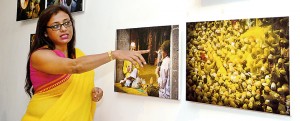Arts
Colourful narratives
When Jayati Saha visited Kashmir with her family last year, she took the stock pictures which the picturesque state dependably obliges with for the tourists who visit.
Snow-fringed mountains framed against the backdrop of clear blue skies, boats floating in the Dal Lake, lush landscapes– Kashmir was beautiful, the people were beautiful, the pictures were beautiful but Jayati remained restless.
She confessed to her husband that she was plagued with a niggling sense that the pictures she had taken did not reveal any of the stories Kashmir had to offer.
Straying off the tourist track, Jayati made a few inquiries, hired a shikara (flat-bottomed wooden boat) and trawled the lesser known parts of Dal Lake and wandered through the Old City, in search of hidden stories.
While walking through a lane, she came across thick bunches of colourful yarn hanging outside a building and was immediately intrigued.

Jayati Saha explains one of her exhibits at the JDA Perera Gallery last week. Pix by Indika Handuwala
The result of her piqued curiousity and keen eye is a remarkably sensitive series depicting the dying art of dyeing in Kashmir. The family business she had chanced upon, created custom dyed yarns for local weavers of the famed shawls and carpets in Kashmir.
The father and son duo would laboriously dye raw yarn with natural homemade dyes all through Kashmir’s summers and water-logged winters.
Through Jayati’s eyes, we see the remnants of a family business and a dwindling specialized craft, once a roaring trade now struggling for survival against time and cheaper substitutes.
This narrative and visual density pervades Kolkata based photographer, Jayati Saha’s photographic oeuvre. A self-taught photographer, her initiation into the field was a result of fiddling around with a cast-off Minolta camera languishing in the depths of a cupboard, when the trusty family point-and-shoot camera was lost.
The Minolta camera was a purchase the family had made and then promptly forgotten about, daunted by the seemingly complex controls and options.
Jayati began experimenting with the camera and started voraciously reading about tips and techniques, mentally planning pictures, wading deeper and deeper into photography.
A lawyer during the week and dabbling with photography during the weekends, Jayati soon realised that one was giving her a warm sense of satisfaction and the other was not.
After 15 years of law it was time to make a decision. “I took a call that this [photography] was my calling. This was a stress buster for me and gives me enjoyment.
I don’t mind being on the road in the peak of summer the entire day – that does not make me tired or want to give up […]I really didn’t want to sit in an AC chamber all day doing something which I don’t enjoy,” recollects Jayati sitting in an Art Gallery in Colombo, surrounded by her photography prints.
Judging by her work over the past years as a travel and documentary photographer and now sought after as a competition judge and teacher, it’s evident this gamble has paid off.
Currently in Colombo for her first solo exhibition, ‘Celebrating Life with Colours’ is divided along three narrative lines and depicts the strands of colour in India’s festivals.
The first series depicts the Somavati Amavasya festival which takes place in Jejuri, a city in Pune.
A no moon day which falls on a Monday (Somvar in Hindi and considered Lord Shiva’s auspicious day) in the Hindu lunar calendar, the town is painted turmeric yellow by the locals and devotees who flock to partake in the rituals.
In the ‘Phoenix’ series, Jayati turns her lens to the famed widows of Vrindavan during the Holi festival.
This series is particularly stunning not for the clouds of colour that accompany the vibrant festival but for the juxtaposition of the tensions that an act of liberation against a social taboo brings.
The usually sombre white garb of the Vrindavan widows is flecked with colour and each picture is taut with emotion. Jayati’s favourite picture is of a group of widows dancing in a courtyard, with confetti raining over them – “I see a lot of joy in that picture”.
Their once-white clothes are now of an uncertain colour and they are bathed in a seemingly divine light. One aged widow has her head thrown back and legs apart in a power pose, just about to throw a fistful of confetti.
The final series in the exhibition are also pictures of Holi – but not of Holi in the streets but how it is celebrated in India’s temples.
Jayati’s pictures take us into temples spanning Jaipur, Rajasthan to Vrindavan and Mathura depicting re-enactments of the Radha-Krishna legends as well as the dances, rituals and the devotees who head to temples to celebrate Holi.
There are traces of Steve McCurry’s influences in Jayati’s work – McCurry has been a source of inspiration for Jayati’s travel photography while Raghu Rai and Sebastian Salgado have inspired her documentary photography.
Currently working on a coffee table book on society imposed and self-adopted renunciation by women along with Delhi based photographer Moushumee K Jha, Jayati is already toying with ideas for her next adventure.
She muses aloud that the Hornbill festival in Nagaland in North East India may be on the cards. Briefly in Nagaland once, she has been eager to travel there again ever since.

